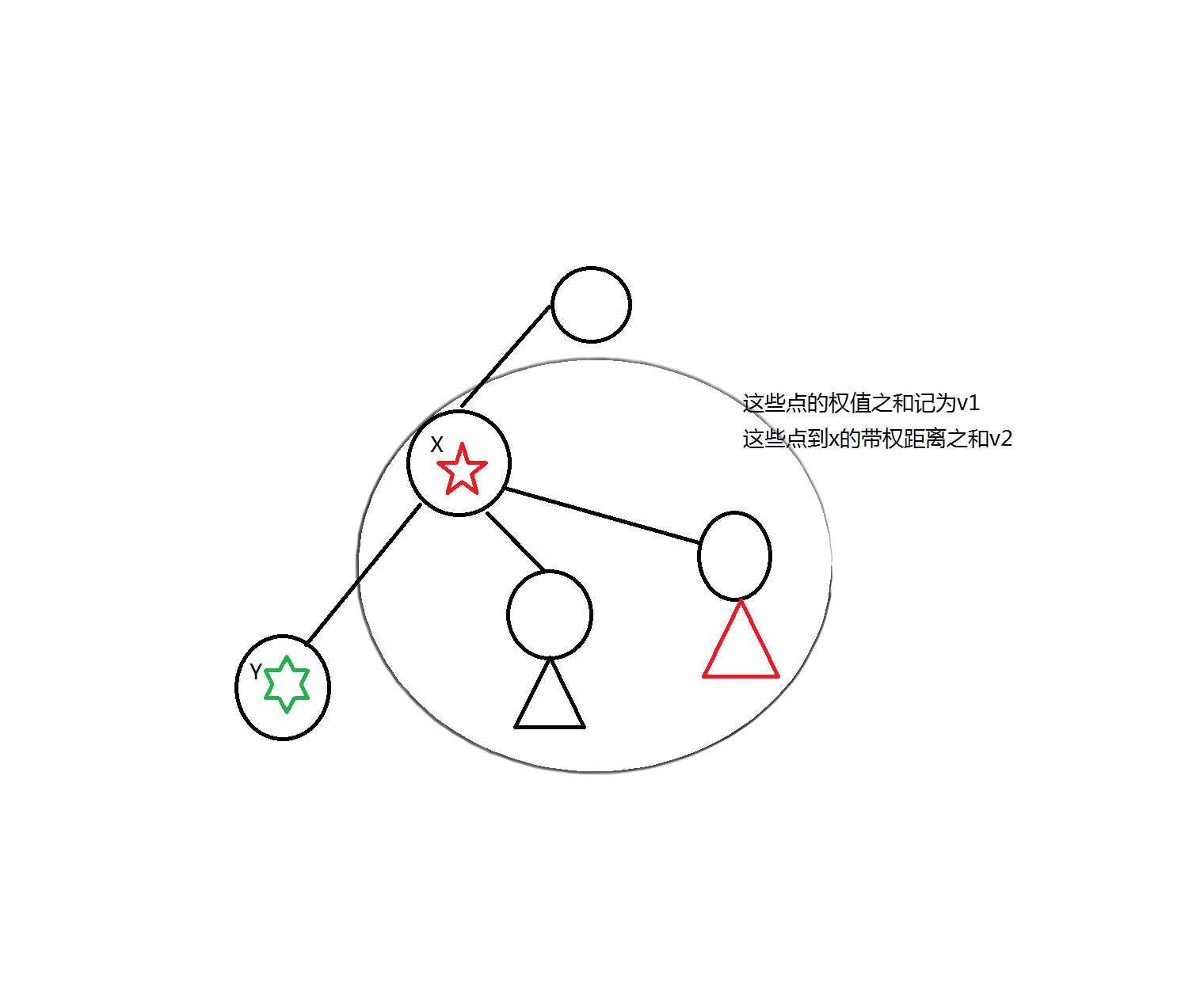BZOJ3924 [Zjoi2015]幻想乡战略游戏
Description
傲娇少女幽香正在玩一个非常有趣的战略类游戏,本来这个游戏的地图其实还不算太大,幽香还能管得过来,但是不知道为什么现在的网游厂商把游戏的地图越做越大,以至于幽香一眼根本看不过来,更别说和别人打仗了。 在打仗之前,幽香现在面临一个非常基本的管理问题需要解决。 整个地图是一个树结构,一共有n块空地,这些空地被n-1条带权边连接起来,使得每两个点之间有一条唯一的路径将它们连接起来。在游戏中,幽香可能在空地上增加或者减少一些军队。同时,幽香可以在一个空地上放置一个补给站。 如果补给站在点u上,并且空地v上有dv个单位的军队,那么幽香每天就要花费dv×dist(u,v)的金钱来补给这些军队。由于幽香需要补给所有的军队,因此幽香总共就要花费为Sigma(Dv*dist(u,v),其中1<=V<=N)的代价。其中dist(u,v)表示u个v在树上的距离(唯一路径的权和)。 因为游戏的规定,幽香只能选择一个空地作为补给站。在游戏的过程中,幽香可能会在某些空地上制造一些军队,也可能会减少某些空地上的军队,进行了这样的操作以后,出于经济上的考虑,幽香往往可以移动他的补给站从而省一些钱。但是由于这个游戏的地图是在太大了,幽香无法轻易的进行最优的安排,你能帮帮她吗? 你可以假定一开始所有空地上都没有军队。
Input
第一行两个数n和Q分别表示树的点数和幽香操作的个数,其中点从1到n标号。 接下来n-1行,每行三个正整数a,b,c,表示a和b之间有一条边权为c的边。 接下来Q行,每行两个数u,e,表示幽香在点u上放了e单位个军队(如果e<0,就相当于是幽香在u上减少了|e|单位个军队,说白了就是du←du+e)。数据保证任何时刻每个点上的军队数量都是非负的。
Output
对于幽香的每个操作,输出操作完成以后,每天的最小花费,也即如果幽香选择最优的补给点进行补给时的花费。
Sample Input
1 2 1
2 3 1
2 4 1
1 5 1
2 61
2 7 1
5 8 1
7 91
1 10 1
3 1
2 1
8 1
3 1
4 1
Sample Output
1
4
5
6
HINT


#include<cstdio> #include<cctype> #include<queue> #include<cstring> #include<algorithm> #define rep(s,t) for(int i=s;i<=t;i++) #define ren for(int i=first[x];i;i=next[i]) #define ren2 for(int i=first2[x];i;i=next2[i]) using namespace std; inline int read() { int x=0,f=1;char c=getchar(); for(;!isdigit(c);c=getchar()) if(c=='-') f=-1; for(;isdigit(c);c=getchar()) x=x*10+c-'0'; return x*f; } typedef long long LL; const int maxn=200010; int n,m,first[maxn],next[maxn],es; struct Edge {int to,dist;}edges[maxn]; void AddEdge(int w,int v,int u) { edges[++es]=(Edge){v,w};next[es]=first[u];first[u]=es; edges[++es]=(Edge){u,w};next[es]=first[v];first[v]=es; } int first2[maxn],next2[maxn],to[maxn],num[maxn],es2; void AddEdge2(int u,int v,int w) { to[++es2]=v;num[es2]=w;next2[es2]=first2[u];first2[u]=es2; } int mn[maxn][21],Log[maxn],pos[maxn],dep[maxn],cnt; void dfs(int x,int fa) { mn[++cnt][0]=dep[x];pos[x]=cnt; ren { Edge& e=edges[i]; if(e.to!=fa) { dep[e.to]=dep[x]+e.dist;dfs(e.to,x); mn[++cnt][0]=dep[x]; } } } int dist(int x,int y) { int ans=dep[x]+dep[y],k; x=pos[x];y=pos[y];if(x>y) swap(x,y); k=Log[y-x+1];return ans-min(mn[x][k],mn[y-(1<<k)+1][k])*2; }//In order to get the LCA of x and y for nlogn times,we should use the "LCA-RMQ algorithm" to calculate. int root,size,s[maxn],f[maxn],vis[maxn]; void getroot(int x,int fa) { s[x]=1;int maxs=0; ren { Edge& e=edges[i]; if(!vis[e.to]&&e.to!=fa) getroot(e.to,x),s[x]+=s[e.to],maxs=max(maxs,s[e.to]); } f[x]=max(maxs,size-s[x]); if(f[root]>f[x]) root=x; } int fa[maxn]; void solve(int x,int F) { vis[x]=1;fa[x]=F; ren { Edge& e=edges[i]; if(!vis[e.to]) { size=f[0]=s[e.to];getroot(e.to,root=0); AddEdge2(x,root,e.to); solve(root,x); } } } LL sum[maxn],dis1[maxn],dis2[maxn]; //sum1[x]=sigma(y's val) | y is included in x's subtree. //dis1[x]=sigma(dist(x,y)) | y is included in x's subtree. //dis2[x]=sigma(dist(fa[x],y)) | y is included in x's subtree. void add(int x,int v) { sum[x]+=v; for(int i=x;fa[i];i=fa[i]) { int d=dist(fa[i],x); dis1[fa[i]]+=(LL)d*v; dis2[i]+=(LL)d*v; sum[fa[i]]+=v; } } LL cal(int x) { LL ret=dis1[x]; for(int i=x;fa[i];i=fa[i]) { int d=dist(fa[i],x); ret+=dis1[fa[i]]-dis2[i]; ret+=d*(sum[fa[i]]-sum[i]); } return ret; } LL query(int x) { LL ans=cal(x); ren2 { LL tmp=cal(num[i]);// Consider x's subnode y in previous tree, if the result is smaller than x then the center of gravity must be in y's conquer 's tree. if(tmp<ans) return query(to[i]); } return ans; } int main() { n=read();m=read(); rep(1,n-1) AddEdge(read(),read(),read()); dfs(1,0);Log[0]=-1; rep(1,cnt) Log[i]=Log[i>>1]+1; for(int j=1;(1<<j)<=cnt;j++) for(int i=1;i+(1<<j)-1<=cnt;i++) mn[i][j]=min(mn[i][j-1],mn[i+(1<<j-1)][j-1]);//pre-process size=f[0]=n;getroot(1,root=0); int t=root;solve(root,0);root=t; while(m--) { int x=read(),v=read(); add(x,v); printf("%lld\n",query(root)); } return 0; }





